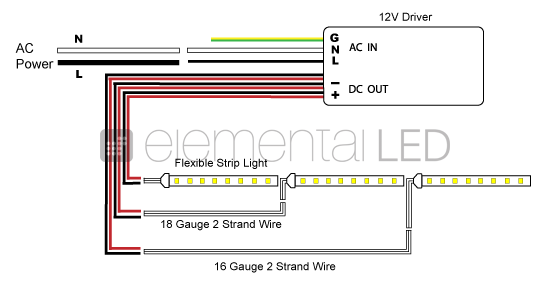Up Top: Quick purchasing guide for linear lighting
| GOOD | BETTER | BEST |
| BLAZE™ Basics | BLAZE™ X | VALENT® X |
For safety reasons and because of the nature of LED light fixture design, LED Strip Lights, Light Bars, and Module Light strings have recommended limitations for the length of run. But it’s relatively easy to make a safe but effective large LED installation by keeping the following things in mind.
1) Observe run limits for your LED fixture.
You’ll find the run limits of feet and fixtures for all our strips, bars, and module lights on the respective product pages. (A “run” is defined as a section of LED strip light or daisy-chained group of fixtures that are running continuously from a single power source.) Observing run limits will result in a safer installation, and help prolong the life of the lights. (Although 12V LEDs can operate in a range of about 10V to 14V, less or more voltage will drastically reduce the life of the bulbs, and cause them to be dimmer than normal.)
2) Don’t overdrive a low-voltage power source.
Powering more than an adapter is rated for will cause the adapter to overheat, which can create a fire. We recommend using only 80% of a power supply’s capacity, which protects against power surges.
3) Use the right amount of power and the right gauge wires to avoid voltage drop.
The wire gauge indicates the thickness of a wire. A lower number is heavier, and a higher number is lighter. The wire gauge of 12V power wires and parallel run wires is also a factor in large installations. (See the first diagram below for an example of a parallel run.) When lighting is at a certain distance from its power source, something called voltage drop occurs. “Voltage drop” is the gradual diminishing of voltage along the length of the wire as electricity travels away from a power source. Voltage drop happens when a light or appliance is located far from the power source.
You can avoid voltage drop by using a voltage drop calculator, which helps you find the right wire gauge based on the number of fixtures in your installation, how they are spaced, and the distance between the power source and the fixtures. We recommend these voltage drop calculators of the many available online: http://www.nooutage.com/vdrop.htm and www.csgnetwork.com/voltagedropcalc.html. Consult your local fire code for additional information about permissible limits on home or commercial electrical wiring.
4) Supply sufficient power.
Another way to get power to a distant fixture is to use a power supply with a higher wattage than necessary. Supplying more power at the source means more will reach the fixture after traveling through the wires. In general, for optimum performance we recommend that a driver not be loaded to more than 80% of its full capacity.
5) Get creative! See our Gallery
Fortunately, there are several ways to install LED lights in large installations that are safe and efficient, just by placing power supplies and using additional wiring. The wiring diagrams below show examples of how to make large installations. Our example wiring diagrams use strip lighting, but the same layout ideas apply to LED light bars and other LED fixtures.
 An example of how to install LED strip lights in a very long, continuous straight line, as you would in a hallway or along a large wall. This type of installation is called a parallel run. Wire gauge here is given as en example; consult a voltage drop calculator and building codes for wire recommendations.
An example of how to install LED strip lights in a very long, continuous straight line, as you would in a hallway or along a large wall. This type of installation is called a parallel run. Wire gauge here is given as en example; consult a voltage drop calculator and building codes for wire recommendations. An example of how to install LED strip lights in a large room. Note the two ways of powering multiple sections of strip with one source: 1) Placing the power source in the middle of two runs, with runs going in opposite directions; 2) Placing the power sources at opposite ends of the two sections so that the runs join seamlessly in a corner.
An example of how to install LED strip lights in a large room. Note the two ways of powering multiple sections of strip with one source: 1) Placing the power source in the middle of two runs, with runs going in opposite directions; 2) Placing the power sources at opposite ends of the two sections so that the runs join seamlessly in a corner.